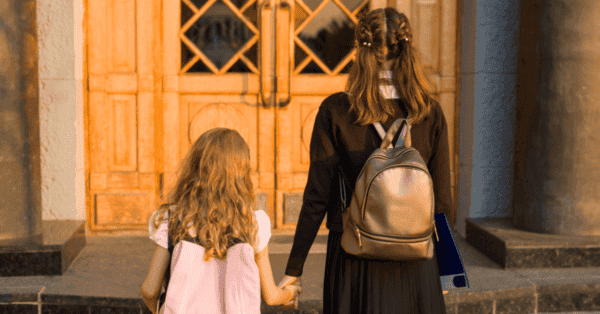Emma is a freelance writer and Mum to four children, including six-year-old twins and an 11-year-old who will be starting secondary school this year.


Emma, mum of four shares, concerns about online peer pressure and online risks as her child makes the move to secondary school.
Although the new school is only a short bus ride away Emma will be giving her daughter a mobile phone just in case. “I’d like to know she can message me if she needs to, whether she’s feeling unsafe, or has forgotten something. We’ve also installed a panic button with GPS tracking on her phone in case she finds herself in danger.”
At 11, Emma’s daughter was feeling left out before she had a phone of her own, says Emma. Now the priority is to ensure that she uses her new phone safely, but also feels confident. “I’ve drummed Internet safety into her as much as I can, and she’s very cautious about strangers trying to friend her on apps,” says Emma. “At the same time, she doesn’t want to be left out of things her friends are involved in, and wants to be able to chat about where she is up to on certain games.”
In secondary school, Emma expects to see more pressure from her daughter around joining social networks, such as Facebook and WhatsApp. “At the moment she understands these things are a firm no, but I’m concerned about the impact of peer pressure. Secondary school is a whole different ball game. It can be fierce and cruel sometimes.”
Emma is particularly concerned because her daughter has suspected auditory processing disorder, which can affect the way she understands conversations. “I think that’s why we have strict rules about online safety, so she can be safe until she’s old enough to handle those conversations herself,” Emma says.
Emma’s two younger children have Kindle Fire tablets that they use in “kid mode”. This limited functionality is not noticed by the children, who enjoy using the apps they are allowed access to. “The tablets are very safe, but I do have to watch them when they’re watching the smart TV as they have a tendency to click off their children’s Netflix profiles and onto YouTube.”
During the week, all of the children have very limited access to their devices, and at weekends there’s a one-hour limit, and a total ban on devices at bedtime. “They do use them a bit more during the holidays, but the one hour a day limit remains in place,” says Emma. “The 11-year-old is allowed to use her phone when she likes, but if she ignores the family, she gets a warning and she puts it away for a while.”
Emma’s biggest concern about secondary school is the peer pressure her daughter will face, and the risk of cyberbullying. “I also worry that she herself could send a text in haste, without thinking about the implication of her words, and what they could mean to others,” says Emma.
To help address these worries, Emma has installed parental control apps that monitor text messages being sent and received. “But when she starts using things like WhatsApp, we have less opportunity to keep her safe,” she adds.
Emma’s advice to other parents is to set solid ground rules and good, parental controls on mobile devices at this age. “Some people might think it intrusive, but there are so many dangers, and hormones flying around, I think our children are very vulnerable.”
Emma relies on the Internet to keep informed on the dangers – and possible solutions. “I read and follow a lot of parent bloggers with children of a similar age, and read news articles on my phone when they crop up,” she says. “I think parents have to be involved because often schools aren’t talking to children about these things enough.”
Emma is a freelance writer and Mum to four children, including six-year-old twins and an 11-year-old who will be starting secondary school this year.

Visit BBC Own It resource for children resource to help them navigate the online world